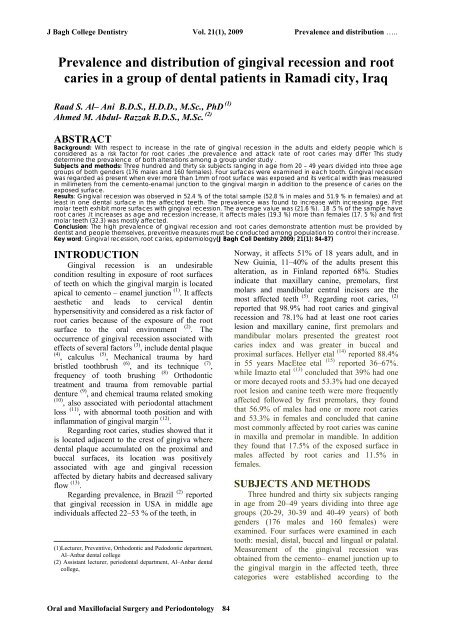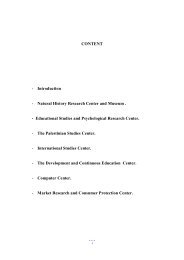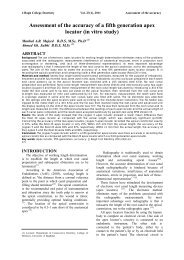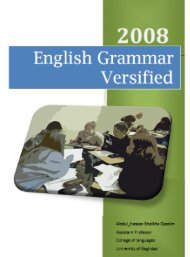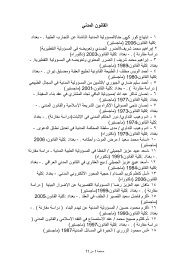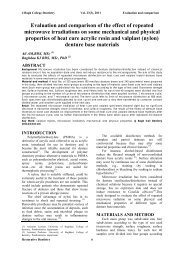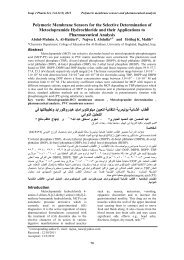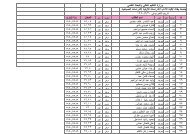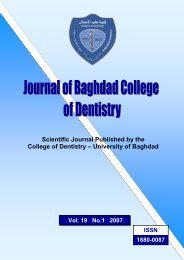Vol 21 No. 1
Vol 21 No. 1
Vol 21 No. 1
You also want an ePaper? Increase the reach of your titles
YUMPU automatically turns print PDFs into web optimized ePapers that Google loves.
J Bagh College Dentistry <strong>Vol</strong>. <strong>21</strong>(1), 2009 Prevalence and distribution …..<br />
Prevalence and distribution of gingival recession and root<br />
caries in a group of dental patients in Ramadi city, Iraq<br />
Raad S. Al– Ani B.D.S., H.D.D., M.Sc., PhD<br />
(1)<br />
Ahmed M. Abdul- Razzak B.D.S., M.Sc.<br />
(2)<br />
ABSTRACT<br />
Background: With respect to increase in the rate of gingival recession in the adults and elderly people which is<br />
considered as a risk factor for root caries ,the prevalence and attack rate of root caries may differ This study<br />
determine the prevalence of both alterations among a group under study .<br />
Subjects and methods: Three hundred and thirty six subjects ranging in age from 20 – 49 years divided into three age<br />
groups of both genders (176 males and 160 females). Four surfaces were examined in each tooth. Gingival recession<br />
was regarded as present when ever more than 1mm of root surface was exposed and its vertical width was measured<br />
in millimeters from the cemento-enamal junction to the gingival margin in addition to the presence of caries on the<br />
exposed surface.<br />
Results: Gingival recession was observed in 52.4 % of the total sample (52.8 % in males and 51.9 % in females) and at<br />
least in one dental surface in the affected teeth. The prevalence was found to increase with increasing age. First<br />
molar teeth exhibit more surfaces with gingival recession. The average value was (<strong>21</strong>.6 %). 18 .5 % of the sample have<br />
root caries .It increases as age and recession increase, it affects males (19.3 %) more than females (17. 5 %) and first<br />
molar teeth (32.3) was mostly affected.<br />
Conclusion: The high prevalence of gingival recession and root caries demonstrate attention must be provided by<br />
dentist and people themselves, preventive measures must be conducted among population to control their increase.<br />
Key word: Gingival recession, root caries, epidemiology(J Bagh Coll Dentistry 2009; <strong>21</strong>(1): 84-87)<br />
INTRODUCTION<br />
Gingival recession is an undesirable<br />
condition resulting in exposure of root surfaces<br />
of teeth on which the gingival margin is located<br />
apical to cemento – enamel junction (1) . It affects<br />
aesthetic and leads to cervical dentin<br />
hypersensitivity and considered as a risk factor of<br />
root caries because of the exposure of the root<br />
surface to the oral environment<br />
(2) . The<br />
occurrence of gingival recession associated with<br />
effects of several factors (3) , include dental plaque<br />
(4) , calculus (5) , Mechanical trauma by hard<br />
bristled toothbrush (6) , and its technique (7) ,<br />
frequency of tooth brushing Orthodontic<br />
treatment and trauma from removable partial<br />
denture (9) , and chemical trauma related smoking<br />
(10) , also associated with periodontal attachment<br />
loss (11) , with abnormal tooth position and with<br />
inflammation of gingival margin (12) .<br />
Regarding root caries, studies showed that it<br />
is located adjacent to the crest of gingiva where<br />
dental plaque accumulated on the proximal and<br />
buccal surfaces, its location was positively<br />
associated with age and gingival recession<br />
affected by dietary habits and decreased salivary<br />
flow (13) .<br />
Regarding prevalence, in Brazil (2) reported<br />
that gingival recession in USA in middle age<br />
individuals affected 22–53 % of the teeth, in<br />
<br />
(1)Lecturer, Preventive, Orthodontic and Pedodontic department,<br />
Al–Anbar dental college<br />
(2) Assistant lecturer, periodontal department, Al–Anbar dental<br />
college,<br />
(8)<br />
<strong>No</strong>rway, it affects 51% of 18 years adult, and in<br />
New Guinia, 11–40% of the adults present this<br />
alteration, as in Finland reported 68%. Studies<br />
indicate that maxillary canine, premolars, first<br />
molars and mandibular central incisors are the<br />
most affected teeth (5) . Regarding root caries, (2)<br />
reported that 98.9% had root caries and gingival<br />
recession and 78.1% had at least one root caries<br />
lesion and maxillary canine, first premolars and<br />
mandibular molars presented the greatest root<br />
caries index and was greater in buccal and<br />
proximal surfaces. Hellyer etal (14) reported 88.4%<br />
in 55 years MacEtee etal (15) reported 36–67%.<br />
while Imazto etal (13) concluded that 39% had one<br />
or more decayed roots and 53.3% had one decayed<br />
root lesion and canine teeth were more frequently<br />
affected followed by first premolars, they found<br />
that 56.9% of males had one or more root caries<br />
and 53.3% in females and concluded that canine<br />
most commonly affected by root caries was canine<br />
in maxilla and premolar in mandible. In addition<br />
they found that 17.5% of the exposed surface in<br />
males affected by root caries and 11.5% in<br />
females.<br />
SUBJECTS AND METHODS<br />
Three hundred and thirty six subjects ranging<br />
in age from 20–49 years dividing into three age<br />
groups (20-29, 30-39 and 40-49 years) of both<br />
genders (176 males and 160 females) were<br />
examined. Four surfaces were examined in each<br />
tooth: mesial, distal, buccal and lingual or palatal.<br />
Measurement of the gingival recession was<br />
obtained from the cemento– enamel junction up to<br />
the gingival margin in the affected teeth, three<br />
categories were established according to the<br />
Oral and Maxillofacial Surgery and Periodontology 84


